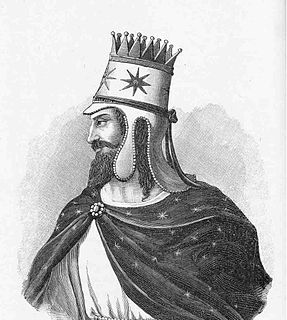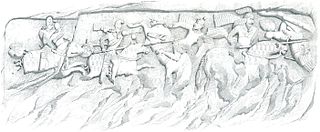
Atropatene, also known as Media Atropatene, was an ancient kingdom established in c. 323 BC by the Persian satrap Atropates. The kingdom, centered in present-day northern Iran, was ruled by Atropates' descendants until the early 1st-century AD, when the Parthian Arsacid dynasty supplanted them. It was conquered by the Sasanians in 226, and turned into a province governed by a marzban ("margrave"). Atropatene was the only Iranian region to remain under Zoroastrian authority from the Achaemenids to the Arab conquest without any interruption, aside from being briefly ruled by the Macedonian king Alexander the Great.

Abu Muslim Abd al-Rahman ibn Muslim al-Khurasani, was a Persian general in service of the Abbasid dynasty, who led the Abbasid Revolution that toppled the Umayyad dynasty.

Bābak Khorramdin was one of the main Iranian revolutionary leaders of the Iranian Khorram-Dinān, which was a local freedom movement fighting the Abbasid Caliphate. Khorramdin appears to be a compound analogous to dorustdin "orthodoxy" and Behdin "Good Religion" (Zoroastrianism), and are considered an offshoot of neo-Mazdakism. Babak's Iranianizing rebellion, from its base in Azerbaijan in northwestern Iran, called for a return of the political glories of the Iranian past. The Khorramdin rebellion of Babak spread to the Western and Central parts of Iran and lasted more than twenty years before it was defeated when Babak was betrayed. Babak's uprising showed the continuing strength in Azerbaijan of ancestral Iranian local feelings.

Pāpak Fort or Babak Castle, ″Ghal’eh-e Baz″ is a large citadel on the top of a mountain in the Arasbaran forests, 50 km from Ahar, one parasang from Ardabil, 6 km southwest of Kalibar City in northwestern Iran. According to Ibn al- Nadim, it was the stronghold of Javidhan and Babak Khorramdin, the leaders of the Khurramites in Iranian Azerbaijan who fought the Islamic caliphate of Abbassids. The fort was conquered and ruined by Afshin′s army on 837.

Artaxias I was the founder of the Artaxiad dynasty of Armenia, ruling from 189 BC to 160 BC. He was succeeded by his son Artavasdes I.

Jibāl was the name given by the Arabs to a region and province located in western Iran, under the Umayyad and Abbasid Caliphates.
Sayyida Shirin, also simply known as Sayyida, was a Bavandid princess, who was the wife of Buyid ruler of Ray, Fakhr al-Dawla. She was the de facto ruler of Ray during the reign of her son, Majd al-Dawla.

The Khurramites were an Iranian religious and political movement with its roots in the movement founded by Mazdak. An alternative name for the movement is the Muḥammira, a reference to their symbolic red dress.

Atropates was a Persian nobleman who served Darius III, then Alexander the Great, and eventually founded an independent kingdom and dynasty that was named after him. Diodorus (18.4) refers to him as 'Atrapes', while Quintus Curtius (8.3.17) erroneously names him 'Arsaces'.

The Kakuyids were a Shia Muslim Iranian Daylamite dynasty that held power in western Persia, Jibal and Persian Iraq. They later became atabegs (governors) of Yazd, Isfahan and Abarkuh from c. 1051 to 1141. They were related to the Buyids.

The Battle of Hormozdgan was the climactic battle between the Arsacid and the Sasanian dynasties that took place on April 28, 224. The Sasanian victory broke the power of the Arsacid dynasty, effectively ending almost five centuries of Parthian rule in Iran, and marking the official start of the Sasanian era.

House of Karen (Middle Persian: Kārēn, Parthian: 𐭊𐭓𐭍𐭉 Kārēn, Persian: کارن Kārin or Kāren, also known as Karen-Pahlav was one of the Seven Great Houses of Iran during the rule of Parthian and Sassanian Empires. The seat of the dynasty was at Nahavand, about 65 km south of Ecbatana. Members of House of Karen were of notable rank in the administrative structure of the Sassanian empire in multiple periods of its four century-long history.
Abuʾl-Ḥasan al-Qāsim Aḥmad ibn Ḥasan Maymandī, better known as Ahmad Maymandi, and also known by his honorific title of Shams al-Kufat, was a Persian vizier of the Ghaznavid Sultan Mahmud of Ghazni and the latter's son Mas'ud I of Ghazni.
Abd al-Razzaq Maymandi was a Persian vizier of the Ghaznavid Sultan Maw'dud Ghaznavi and Abd al-Rashid.
Abd al-Hamid ibn Ahmad ibn Abd al-Samad Shirazi, better known as Abd al-Hamid Shirazi, was a Persian vizier of the Ghaznavid Sultan Ibrahim and the latter's son Mas'ud III.
Abu Nasr Mansur ibn Moshkan, better simply known as Abu Nasr Moshkan, was a Persian statesman who served as the head of the Ghaznavid chancery from 1011/2 till his death in 1039/40. His nephew, Tahir ibn Ali ibn Moshkan, known by his title of Thiqat al-Mulk, served as the vizier of Sultan Mas'ud III.
The Bal'ami family was a Persian family native to Khorasan and Transoxiana. The most famous members were Abu'l-Fadl al-Bal'ami and his son Muhammad Bal'ami.
Khwaja Abu Nasr Ahmad, better known as Ahmad Shirazi, also known as Ahmad(-e) Abd al-Samad, was a Persian vizier of the Ghaznavid Sultan Mas'ud I and the latter's son Mawdud from 1032 to 1043. He was the son of the Samanid secretary Abu Tahir Shirazi, and had a son named Abd al-Hamid Shirazi, who would also later serve as vizier.

Ghazni is a city in southeastern Afghanistan, which served as the capital of the Ghaznavid Empire from 977 to 1163.











